Leadership and Management in Business: An Analysis of Imda Tech Report
VerifiedAdded on 2023/04/04
|10
|3782
|137
Report
AI Summary
This report provides an in-depth analysis of leadership and management principles within the context of Imda Tech. It begins by outlining the necessary documentation for recruiting and selecting new staff members, evaluating the legal considerations in the process, and detailing the steps involved in participating in and contributing to the selection process. The report then delves into leadership skills, distinguishing between leadership and management, explaining various leadership styles (autocratic, democratic, laissez-faire, and paternalistic), and exploring methods for motivating staff. Furthermore, it examines the benefits of teamwork, demonstrating the roles of team members and leaders, and evaluating team effectiveness. Finally, the report describes factors in planning, monitoring, and assessing work performance, including planning the assessment of individual development needs and analyzing the success of the assessment process. The report highlights the importance of effective leadership, recruitment, and teamwork for organizational success.
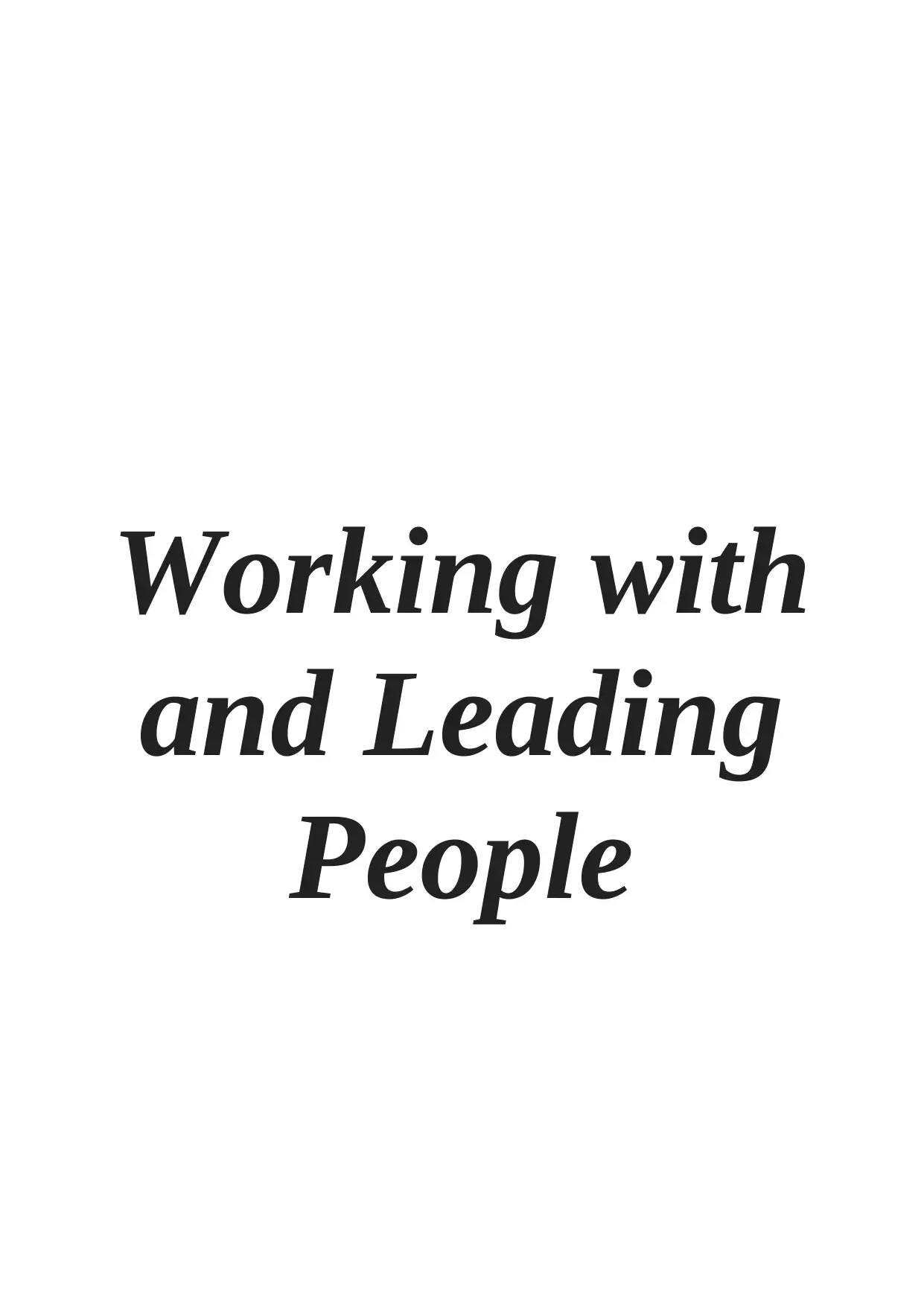
Working with
and Leading
People
and Leading
People
Paraphrase This Document
Need a fresh take? Get an instant paraphrase of this document with our AI Paraphraser
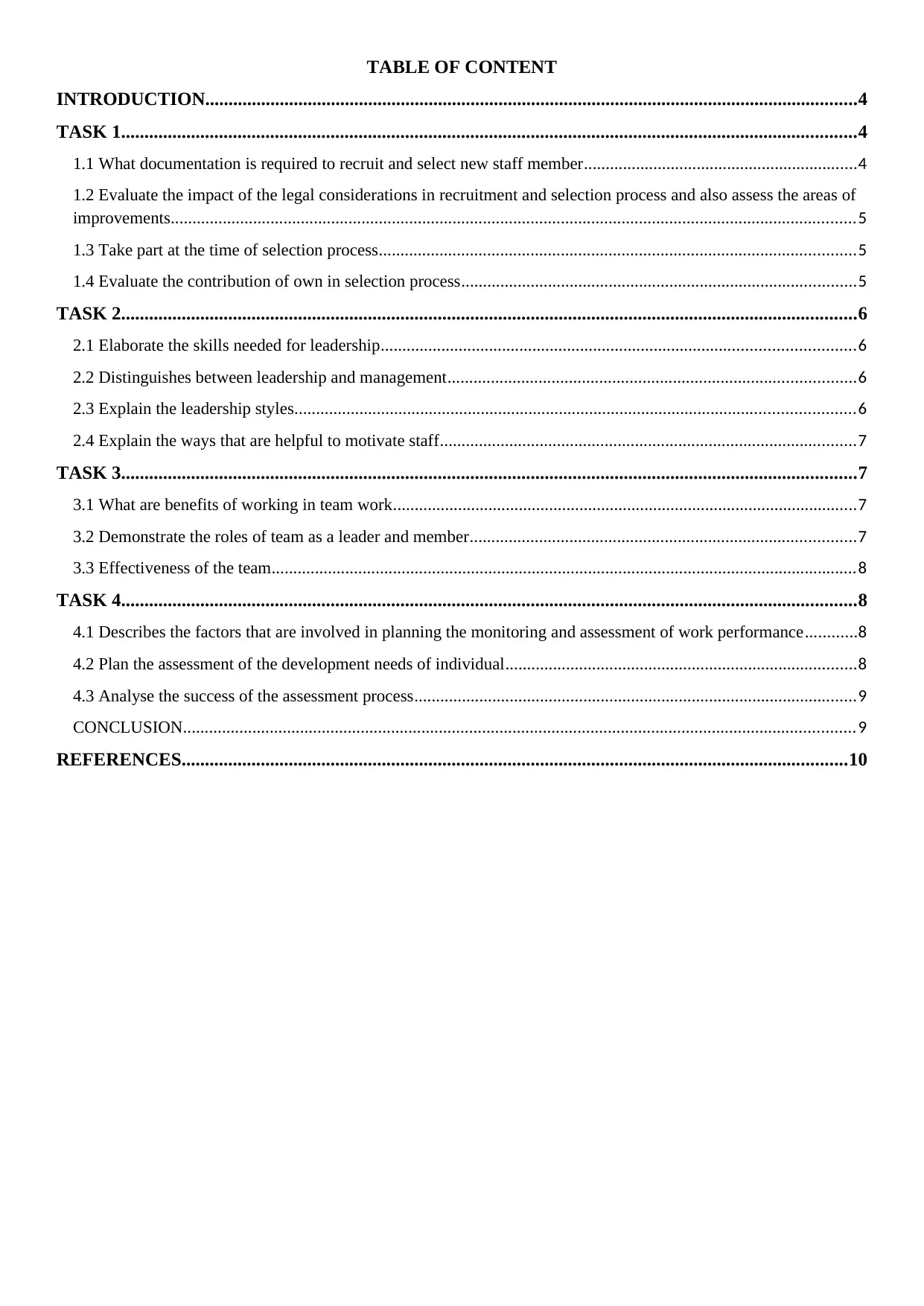
TABLE OF CONTENT
INTRODUCTION............................................................................................................................................4
TASK 1..............................................................................................................................................................4
1.1 What documentation is required to recruit and select new staff member...............................................................4
1.2 Evaluate the impact of the legal considerations in recruitment and selection process and also assess the areas of
improvements..............................................................................................................................................................5
1.3 Take part at the time of selection process..............................................................................................................5
1.4 Evaluate the contribution of own in selection process...........................................................................................5
TASK 2..............................................................................................................................................................6
2.1 Elaborate the skills needed for leadership.............................................................................................................6
2.2 Distinguishes between leadership and management..............................................................................................6
2.3 Explain the leadership styles.................................................................................................................................6
2.4 Explain the ways that are helpful to motivate staff................................................................................................7
TASK 3..............................................................................................................................................................7
3.1 What are benefits of working in team work...........................................................................................................7
3.2 Demonstrate the roles of team as a leader and member.........................................................................................7
3.3 Effectiveness of the team.......................................................................................................................................8
TASK 4..............................................................................................................................................................8
4.1 Describes the factors that are involved in planning the monitoring and assessment of work performance............8
4.2 Plan the assessment of the development needs of individual.................................................................................8
4.3 Analyse the success of the assessment process......................................................................................................9
CONCLUSION...........................................................................................................................................................9
REFERENCES...............................................................................................................................................10
INTRODUCTION............................................................................................................................................4
TASK 1..............................................................................................................................................................4
1.1 What documentation is required to recruit and select new staff member...............................................................4
1.2 Evaluate the impact of the legal considerations in recruitment and selection process and also assess the areas of
improvements..............................................................................................................................................................5
1.3 Take part at the time of selection process..............................................................................................................5
1.4 Evaluate the contribution of own in selection process...........................................................................................5
TASK 2..............................................................................................................................................................6
2.1 Elaborate the skills needed for leadership.............................................................................................................6
2.2 Distinguishes between leadership and management..............................................................................................6
2.3 Explain the leadership styles.................................................................................................................................6
2.4 Explain the ways that are helpful to motivate staff................................................................................................7
TASK 3..............................................................................................................................................................7
3.1 What are benefits of working in team work...........................................................................................................7
3.2 Demonstrate the roles of team as a leader and member.........................................................................................7
3.3 Effectiveness of the team.......................................................................................................................................8
TASK 4..............................................................................................................................................................8
4.1 Describes the factors that are involved in planning the monitoring and assessment of work performance............8
4.2 Plan the assessment of the development needs of individual.................................................................................8
4.3 Analyse the success of the assessment process......................................................................................................9
CONCLUSION...........................................................................................................................................................9
REFERENCES...............................................................................................................................................10
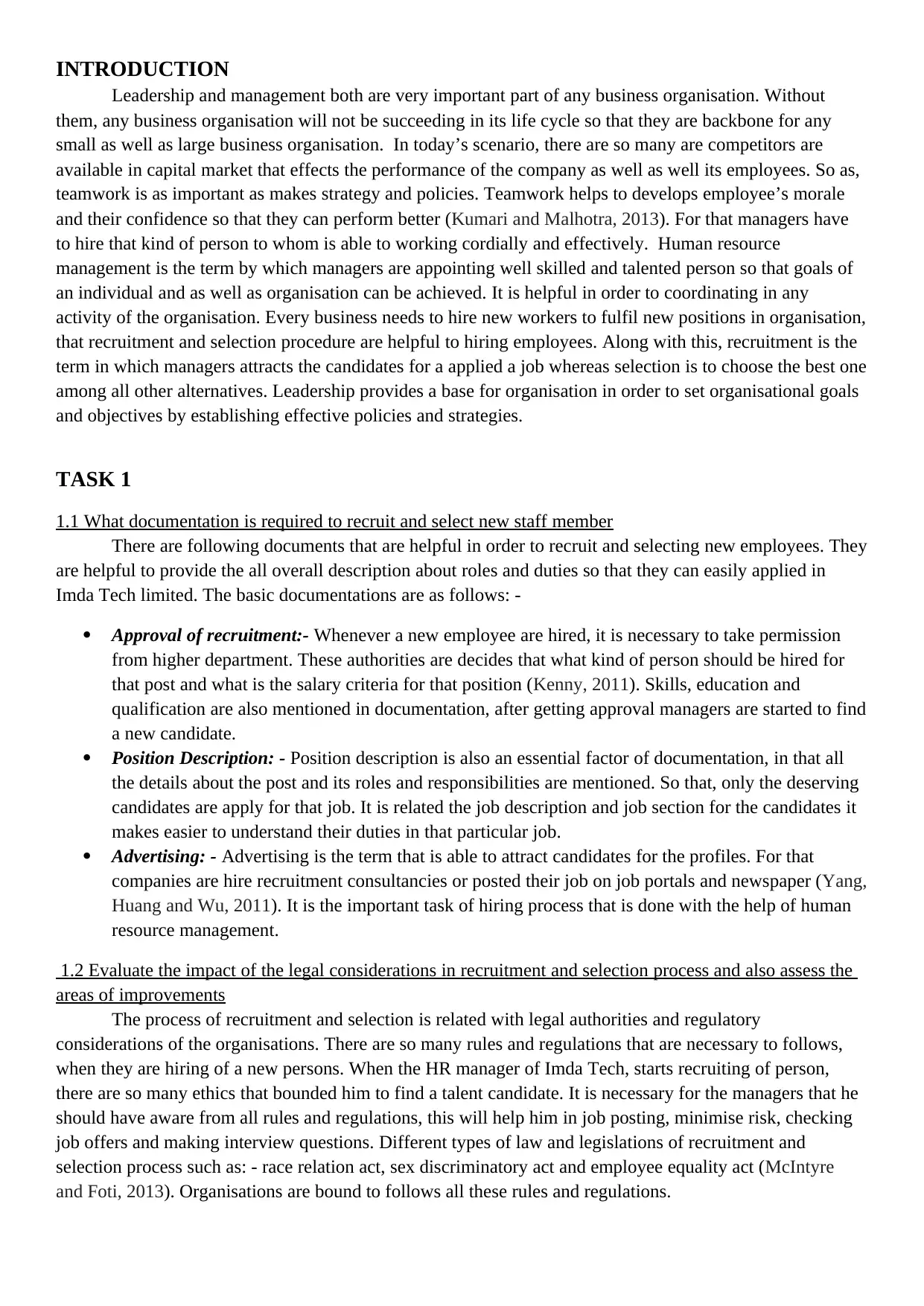
INTRODUCTION
Leadership and management both are very important part of any business organisation. Without
them, any business organisation will not be succeeding in its life cycle so that they are backbone for any
small as well as large business organisation. In today’s scenario, there are so many are competitors are
available in capital market that effects the performance of the company as well as well its employees. So as,
teamwork is as important as makes strategy and policies. Teamwork helps to develops employee’s morale
and their confidence so that they can perform better (Kumari and Malhotra, 2013). For that managers have
to hire that kind of person to whom is able to working cordially and effectively. Human resource
management is the term by which managers are appointing well skilled and talented person so that goals of
an individual and as well as organisation can be achieved. It is helpful in order to coordinating in any
activity of the organisation. Every business needs to hire new workers to fulfil new positions in organisation,
that recruitment and selection procedure are helpful to hiring employees. Along with this, recruitment is the
term in which managers attracts the candidates for a applied a job whereas selection is to choose the best one
among all other alternatives. Leadership provides a base for organisation in order to set organisational goals
and objectives by establishing effective policies and strategies.
TASK 1
1.1 What documentation is required to recruit and select new staff member
There are following documents that are helpful in order to recruit and selecting new employees. They
are helpful to provide the all overall description about roles and duties so that they can easily applied in
Imda Tech limited. The basic documentations are as follows: -
Approval of recruitment:- Whenever a new employee are hired, it is necessary to take permission
from higher department. These authorities are decides that what kind of person should be hired for
that post and what is the salary criteria for that position (Kenny, 2011). Skills, education and
qualification are also mentioned in documentation, after getting approval managers are started to find
a new candidate.
Position Description: - Position description is also an essential factor of documentation, in that all
the details about the post and its roles and responsibilities are mentioned. So that, only the deserving
candidates are apply for that job. It is related the job description and job section for the candidates it
makes easier to understand their duties in that particular job.
Advertising: - Advertising is the term that is able to attract candidates for the profiles. For that
companies are hire recruitment consultancies or posted their job on job portals and newspaper (Yang,
Huang and Wu, 2011). It is the important task of hiring process that is done with the help of human
resource management.
1.2 Evaluate the impact of the legal considerations in recruitment and selection process and also assess the
areas of improvements
The process of recruitment and selection is related with legal authorities and regulatory
considerations of the organisations. There are so many rules and regulations that are necessary to follows,
when they are hiring of a new persons. When the HR manager of Imda Tech, starts recruiting of person,
there are so many ethics that bounded him to find a talent candidate. It is necessary for the managers that he
should have aware from all rules and regulations, this will help him in job posting, minimise risk, checking
job offers and making interview questions. Different types of law and legislations of recruitment and
selection process such as: - race relation act, sex discriminatory act and employee equality act (McIntyre
and Foti, 2013). Organisations are bound to follows all these rules and regulations.
Leadership and management both are very important part of any business organisation. Without
them, any business organisation will not be succeeding in its life cycle so that they are backbone for any
small as well as large business organisation. In today’s scenario, there are so many are competitors are
available in capital market that effects the performance of the company as well as well its employees. So as,
teamwork is as important as makes strategy and policies. Teamwork helps to develops employee’s morale
and their confidence so that they can perform better (Kumari and Malhotra, 2013). For that managers have
to hire that kind of person to whom is able to working cordially and effectively. Human resource
management is the term by which managers are appointing well skilled and talented person so that goals of
an individual and as well as organisation can be achieved. It is helpful in order to coordinating in any
activity of the organisation. Every business needs to hire new workers to fulfil new positions in organisation,
that recruitment and selection procedure are helpful to hiring employees. Along with this, recruitment is the
term in which managers attracts the candidates for a applied a job whereas selection is to choose the best one
among all other alternatives. Leadership provides a base for organisation in order to set organisational goals
and objectives by establishing effective policies and strategies.
TASK 1
1.1 What documentation is required to recruit and select new staff member
There are following documents that are helpful in order to recruit and selecting new employees. They
are helpful to provide the all overall description about roles and duties so that they can easily applied in
Imda Tech limited. The basic documentations are as follows: -
Approval of recruitment:- Whenever a new employee are hired, it is necessary to take permission
from higher department. These authorities are decides that what kind of person should be hired for
that post and what is the salary criteria for that position (Kenny, 2011). Skills, education and
qualification are also mentioned in documentation, after getting approval managers are started to find
a new candidate.
Position Description: - Position description is also an essential factor of documentation, in that all
the details about the post and its roles and responsibilities are mentioned. So that, only the deserving
candidates are apply for that job. It is related the job description and job section for the candidates it
makes easier to understand their duties in that particular job.
Advertising: - Advertising is the term that is able to attract candidates for the profiles. For that
companies are hire recruitment consultancies or posted their job on job portals and newspaper (Yang,
Huang and Wu, 2011). It is the important task of hiring process that is done with the help of human
resource management.
1.2 Evaluate the impact of the legal considerations in recruitment and selection process and also assess the
areas of improvements
The process of recruitment and selection is related with legal authorities and regulatory
considerations of the organisations. There are so many rules and regulations that are necessary to follows,
when they are hiring of a new persons. When the HR manager of Imda Tech, starts recruiting of person,
there are so many ethics that bounded him to find a talent candidate. It is necessary for the managers that he
should have aware from all rules and regulations, this will help him in job posting, minimise risk, checking
job offers and making interview questions. Different types of law and legislations of recruitment and
selection process such as: - race relation act, sex discriminatory act and employee equality act (McIntyre
and Foti, 2013). Organisations are bound to follows all these rules and regulations.
⊘ This is a preview!⊘
Do you want full access?
Subscribe today to unlock all pages.

Trusted by 1+ million students worldwide
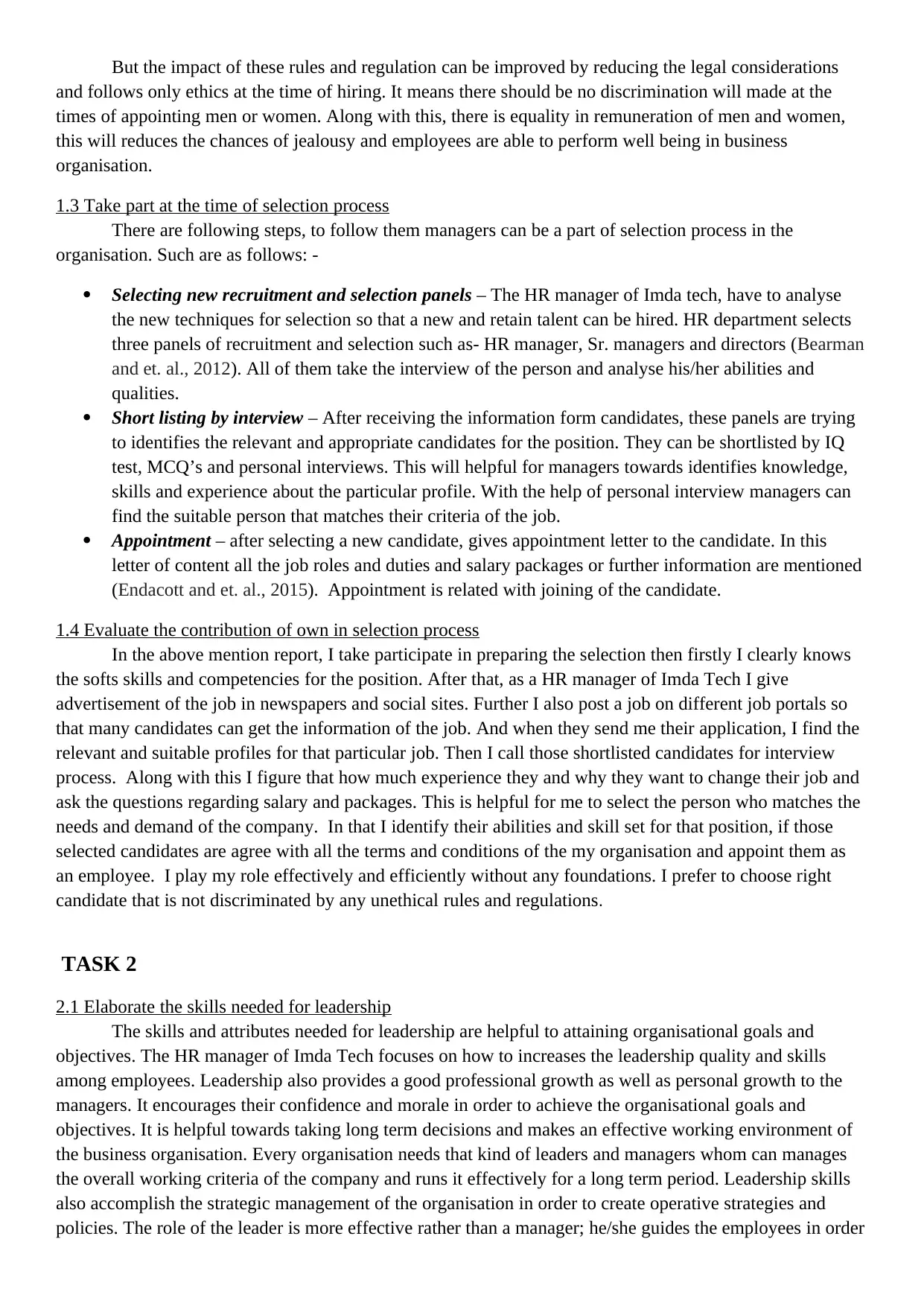
But the impact of these rules and regulation can be improved by reducing the legal considerations
and follows only ethics at the time of hiring. It means there should be no discrimination will made at the
times of appointing men or women. Along with this, there is equality in remuneration of men and women,
this will reduces the chances of jealousy and employees are able to perform well being in business
organisation.
1.3 Take part at the time of selection process
There are following steps, to follow them managers can be a part of selection process in the
organisation. Such are as follows: -
Selecting new recruitment and selection panels – The HR manager of Imda tech, have to analyse
the new techniques for selection so that a new and retain talent can be hired. HR department selects
three panels of recruitment and selection such as- HR manager, Sr. managers and directors (Bearman
and et. al., 2012). All of them take the interview of the person and analyse his/her abilities and
qualities.
Short listing by interview – After receiving the information form candidates, these panels are trying
to identifies the relevant and appropriate candidates for the position. They can be shortlisted by IQ
test, MCQ’s and personal interviews. This will helpful for managers towards identifies knowledge,
skills and experience about the particular profile. With the help of personal interview managers can
find the suitable person that matches their criteria of the job.
Appointment – after selecting a new candidate, gives appointment letter to the candidate. In this
letter of content all the job roles and duties and salary packages or further information are mentioned
(Endacott and et. al., 2015). Appointment is related with joining of the candidate.
1.4 Evaluate the contribution of own in selection process
In the above mention report, I take participate in preparing the selection then firstly I clearly knows
the softs skills and competencies for the position. After that, as a HR manager of Imda Tech I give
advertisement of the job in newspapers and social sites. Further I also post a job on different job portals so
that many candidates can get the information of the job. And when they send me their application, I find the
relevant and suitable profiles for that particular job. Then I call those shortlisted candidates for interview
process. Along with this I figure that how much experience they and why they want to change their job and
ask the questions regarding salary and packages. This is helpful for me to select the person who matches the
needs and demand of the company. In that I identify their abilities and skill set for that position, if those
selected candidates are agree with all the terms and conditions of the my organisation and appoint them as
an employee. I play my role effectively and efficiently without any foundations. I prefer to choose right
candidate that is not discriminated by any unethical rules and regulations.
TASK 2
2.1 Elaborate the skills needed for leadership
The skills and attributes needed for leadership are helpful to attaining organisational goals and
objectives. The HR manager of Imda Tech focuses on how to increases the leadership quality and skills
among employees. Leadership also provides a good professional growth as well as personal growth to the
managers. It encourages their confidence and morale in order to achieve the organisational goals and
objectives. It is helpful towards taking long term decisions and makes an effective working environment of
the business organisation. Every organisation needs that kind of leaders and managers whom can manages
the overall working criteria of the company and runs it effectively for a long term period. Leadership skills
also accomplish the strategic management of the organisation in order to create operative strategies and
policies. The role of the leader is more effective rather than a manager; he/she guides the employees in order
and follows only ethics at the time of hiring. It means there should be no discrimination will made at the
times of appointing men or women. Along with this, there is equality in remuneration of men and women,
this will reduces the chances of jealousy and employees are able to perform well being in business
organisation.
1.3 Take part at the time of selection process
There are following steps, to follow them managers can be a part of selection process in the
organisation. Such are as follows: -
Selecting new recruitment and selection panels – The HR manager of Imda tech, have to analyse
the new techniques for selection so that a new and retain talent can be hired. HR department selects
three panels of recruitment and selection such as- HR manager, Sr. managers and directors (Bearman
and et. al., 2012). All of them take the interview of the person and analyse his/her abilities and
qualities.
Short listing by interview – After receiving the information form candidates, these panels are trying
to identifies the relevant and appropriate candidates for the position. They can be shortlisted by IQ
test, MCQ’s and personal interviews. This will helpful for managers towards identifies knowledge,
skills and experience about the particular profile. With the help of personal interview managers can
find the suitable person that matches their criteria of the job.
Appointment – after selecting a new candidate, gives appointment letter to the candidate. In this
letter of content all the job roles and duties and salary packages or further information are mentioned
(Endacott and et. al., 2015). Appointment is related with joining of the candidate.
1.4 Evaluate the contribution of own in selection process
In the above mention report, I take participate in preparing the selection then firstly I clearly knows
the softs skills and competencies for the position. After that, as a HR manager of Imda Tech I give
advertisement of the job in newspapers and social sites. Further I also post a job on different job portals so
that many candidates can get the information of the job. And when they send me their application, I find the
relevant and suitable profiles for that particular job. Then I call those shortlisted candidates for interview
process. Along with this I figure that how much experience they and why they want to change their job and
ask the questions regarding salary and packages. This is helpful for me to select the person who matches the
needs and demand of the company. In that I identify their abilities and skill set for that position, if those
selected candidates are agree with all the terms and conditions of the my organisation and appoint them as
an employee. I play my role effectively and efficiently without any foundations. I prefer to choose right
candidate that is not discriminated by any unethical rules and regulations.
TASK 2
2.1 Elaborate the skills needed for leadership
The skills and attributes needed for leadership are helpful to attaining organisational goals and
objectives. The HR manager of Imda Tech focuses on how to increases the leadership quality and skills
among employees. Leadership also provides a good professional growth as well as personal growth to the
managers. It encourages their confidence and morale in order to achieve the organisational goals and
objectives. It is helpful towards taking long term decisions and makes an effective working environment of
the business organisation. Every organisation needs that kind of leaders and managers whom can manages
the overall working criteria of the company and runs it effectively for a long term period. Leadership skills
also accomplish the strategic management of the organisation in order to create operative strategies and
policies. The role of the leader is more effective rather than a manager; he/she guides the employees in order
Paraphrase This Document
Need a fresh take? Get an instant paraphrase of this document with our AI Paraphraser
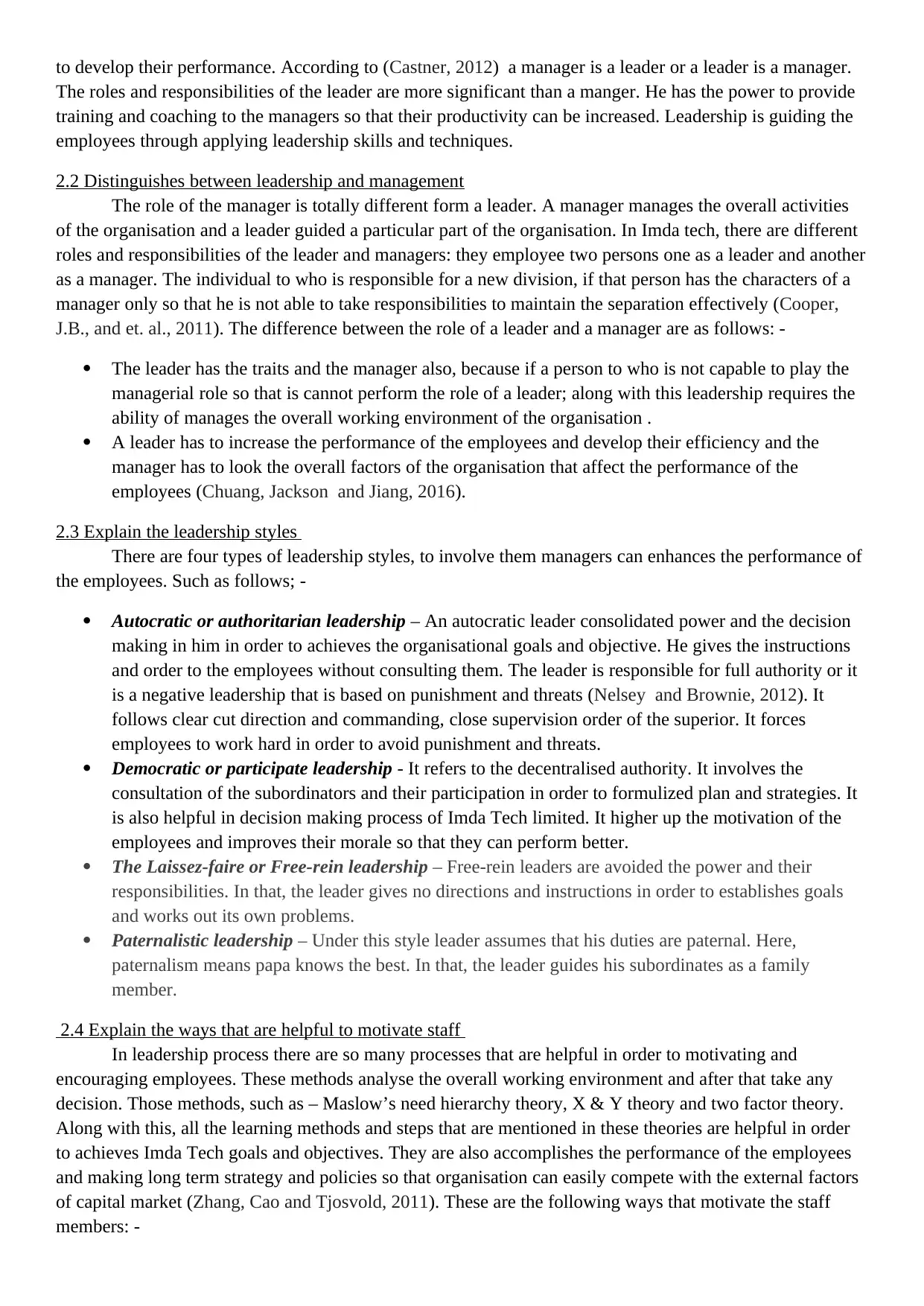
to develop their performance. According to (Castner, 2012) a manager is a leader or a leader is a manager.
The roles and responsibilities of the leader are more significant than a manger. He has the power to provide
training and coaching to the managers so that their productivity can be increased. Leadership is guiding the
employees through applying leadership skills and techniques.
2.2 Distinguishes between leadership and management
The role of the manager is totally different form a leader. A manager manages the overall activities
of the organisation and a leader guided a particular part of the organisation. In Imda tech, there are different
roles and responsibilities of the leader and managers: they employee two persons one as a leader and another
as a manager. The individual to who is responsible for a new division, if that person has the characters of a
manager only so that he is not able to take responsibilities to maintain the separation effectively (Cooper,
J.B., and et. al., 2011). The difference between the role of a leader and a manager are as follows: -
The leader has the traits and the manager also, because if a person to who is not capable to play the
managerial role so that is cannot perform the role of a leader; along with this leadership requires the
ability of manages the overall working environment of the organisation .
A leader has to increase the performance of the employees and develop their efficiency and the
manager has to look the overall factors of the organisation that affect the performance of the
employees (Chuang, Jackson and Jiang, 2016).
2.3 Explain the leadership styles
There are four types of leadership styles, to involve them managers can enhances the performance of
the employees. Such as follows; -
Autocratic or authoritarian leadership – An autocratic leader consolidated power and the decision
making in him in order to achieves the organisational goals and objective. He gives the instructions
and order to the employees without consulting them. The leader is responsible for full authority or it
is a negative leadership that is based on punishment and threats (Nelsey and Brownie, 2012). It
follows clear cut direction and commanding, close supervision order of the superior. It forces
employees to work hard in order to avoid punishment and threats.
Democratic or participate leadership - It refers to the decentralised authority. It involves the
consultation of the subordinators and their participation in order to formulized plan and strategies. It
is also helpful in decision making process of Imda Tech limited. It higher up the motivation of the
employees and improves their morale so that they can perform better.
The Laissez-faire or Free-rein leadership – Free-rein leaders are avoided the power and their
responsibilities. In that, the leader gives no directions and instructions in order to establishes goals
and works out its own problems.
Paternalistic leadership – Under this style leader assumes that his duties are paternal. Here,
paternalism means papa knows the best. In that, the leader guides his subordinates as a family
member.
2.4 Explain the ways that are helpful to motivate staff
In leadership process there are so many processes that are helpful in order to motivating and
encouraging employees. These methods analyse the overall working environment and after that take any
decision. Those methods, such as – Maslow’s need hierarchy theory, X & Y theory and two factor theory.
Along with this, all the learning methods and steps that are mentioned in these theories are helpful in order
to achieves Imda Tech goals and objectives. They are also accomplishes the performance of the employees
and making long term strategy and policies so that organisation can easily compete with the external factors
of capital market (Zhang, Cao and Tjosvold, 2011). These are the following ways that motivate the staff
members: -
The roles and responsibilities of the leader are more significant than a manger. He has the power to provide
training and coaching to the managers so that their productivity can be increased. Leadership is guiding the
employees through applying leadership skills and techniques.
2.2 Distinguishes between leadership and management
The role of the manager is totally different form a leader. A manager manages the overall activities
of the organisation and a leader guided a particular part of the organisation. In Imda tech, there are different
roles and responsibilities of the leader and managers: they employee two persons one as a leader and another
as a manager. The individual to who is responsible for a new division, if that person has the characters of a
manager only so that he is not able to take responsibilities to maintain the separation effectively (Cooper,
J.B., and et. al., 2011). The difference between the role of a leader and a manager are as follows: -
The leader has the traits and the manager also, because if a person to who is not capable to play the
managerial role so that is cannot perform the role of a leader; along with this leadership requires the
ability of manages the overall working environment of the organisation .
A leader has to increase the performance of the employees and develop their efficiency and the
manager has to look the overall factors of the organisation that affect the performance of the
employees (Chuang, Jackson and Jiang, 2016).
2.3 Explain the leadership styles
There are four types of leadership styles, to involve them managers can enhances the performance of
the employees. Such as follows; -
Autocratic or authoritarian leadership – An autocratic leader consolidated power and the decision
making in him in order to achieves the organisational goals and objective. He gives the instructions
and order to the employees without consulting them. The leader is responsible for full authority or it
is a negative leadership that is based on punishment and threats (Nelsey and Brownie, 2012). It
follows clear cut direction and commanding, close supervision order of the superior. It forces
employees to work hard in order to avoid punishment and threats.
Democratic or participate leadership - It refers to the decentralised authority. It involves the
consultation of the subordinators and their participation in order to formulized plan and strategies. It
is also helpful in decision making process of Imda Tech limited. It higher up the motivation of the
employees and improves their morale so that they can perform better.
The Laissez-faire or Free-rein leadership – Free-rein leaders are avoided the power and their
responsibilities. In that, the leader gives no directions and instructions in order to establishes goals
and works out its own problems.
Paternalistic leadership – Under this style leader assumes that his duties are paternal. Here,
paternalism means papa knows the best. In that, the leader guides his subordinates as a family
member.
2.4 Explain the ways that are helpful to motivate staff
In leadership process there are so many processes that are helpful in order to motivating and
encouraging employees. These methods analyse the overall working environment and after that take any
decision. Those methods, such as – Maslow’s need hierarchy theory, X & Y theory and two factor theory.
Along with this, all the learning methods and steps that are mentioned in these theories are helpful in order
to achieves Imda Tech goals and objectives. They are also accomplishes the performance of the employees
and making long term strategy and policies so that organisation can easily compete with the external factors
of capital market (Zhang, Cao and Tjosvold, 2011). These are the following ways that motivate the staff
members: -
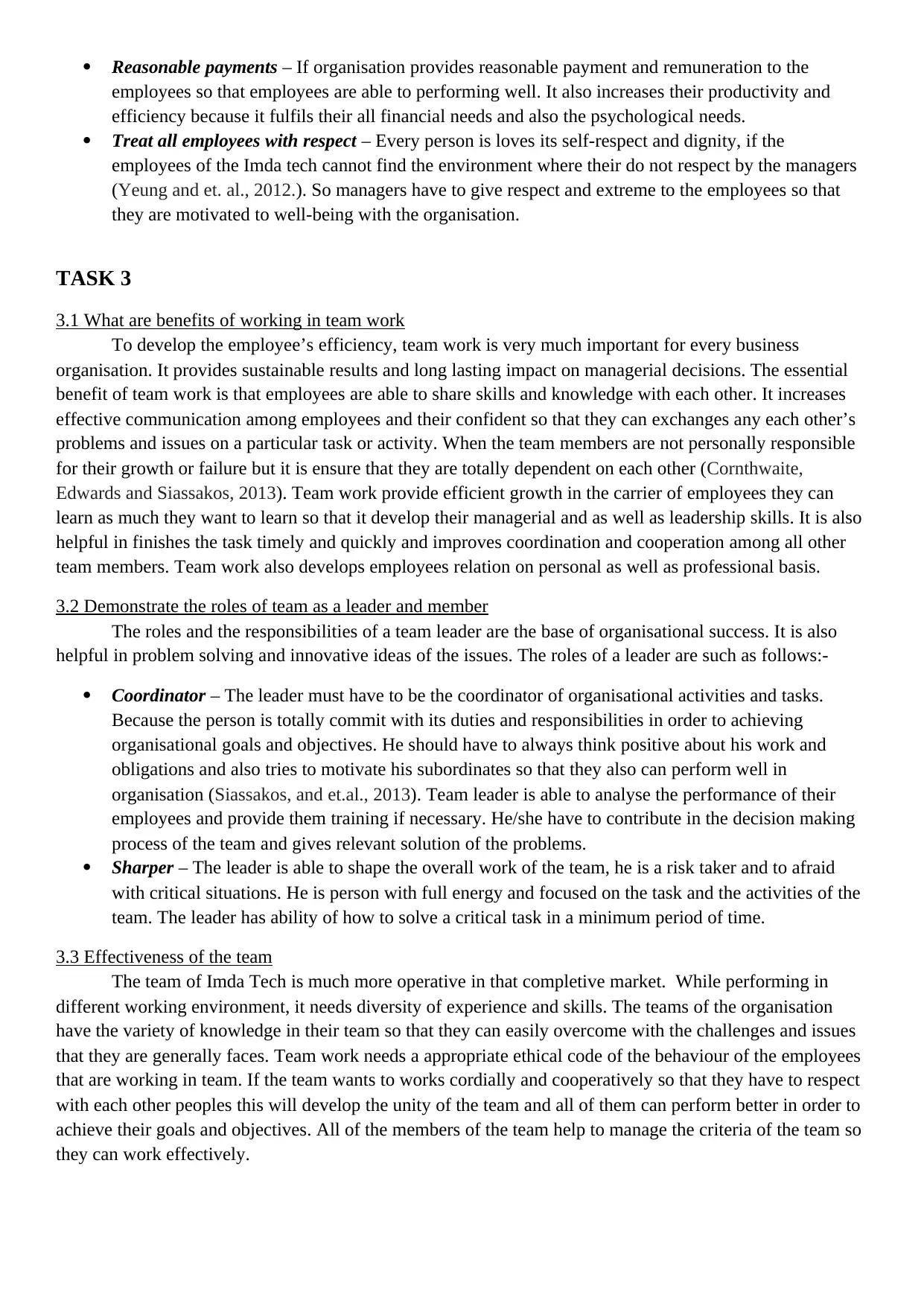
Reasonable payments – If organisation provides reasonable payment and remuneration to the
employees so that employees are able to performing well. It also increases their productivity and
efficiency because it fulfils their all financial needs and also the psychological needs.
Treat all employees with respect – Every person is loves its self-respect and dignity, if the
employees of the Imda tech cannot find the environment where their do not respect by the managers
(Yeung and et. al., 2012.). So managers have to give respect and extreme to the employees so that
they are motivated to well-being with the organisation.
TASK 3
3.1 What are benefits of working in team work
To develop the employee’s efficiency, team work is very much important for every business
organisation. It provides sustainable results and long lasting impact on managerial decisions. The essential
benefit of team work is that employees are able to share skills and knowledge with each other. It increases
effective communication among employees and their confident so that they can exchanges any each other’s
problems and issues on a particular task or activity. When the team members are not personally responsible
for their growth or failure but it is ensure that they are totally dependent on each other (Cornthwaite,
Edwards and Siassakos, 2013). Team work provide efficient growth in the carrier of employees they can
learn as much they want to learn so that it develop their managerial and as well as leadership skills. It is also
helpful in finishes the task timely and quickly and improves coordination and cooperation among all other
team members. Team work also develops employees relation on personal as well as professional basis.
3.2 Demonstrate the roles of team as a leader and member
The roles and the responsibilities of a team leader are the base of organisational success. It is also
helpful in problem solving and innovative ideas of the issues. The roles of a leader are such as follows:-
Coordinator – The leader must have to be the coordinator of organisational activities and tasks.
Because the person is totally commit with its duties and responsibilities in order to achieving
organisational goals and objectives. He should have to always think positive about his work and
obligations and also tries to motivate his subordinates so that they also can perform well in
organisation (Siassakos, and et.al., 2013). Team leader is able to analyse the performance of their
employees and provide them training if necessary. He/she have to contribute in the decision making
process of the team and gives relevant solution of the problems.
Sharper – The leader is able to shape the overall work of the team, he is a risk taker and to afraid
with critical situations. He is person with full energy and focused on the task and the activities of the
team. The leader has ability of how to solve a critical task in a minimum period of time.
3.3 Effectiveness of the team
The team of Imda Tech is much more operative in that completive market. While performing in
different working environment, it needs diversity of experience and skills. The teams of the organisation
have the variety of knowledge in their team so that they can easily overcome with the challenges and issues
that they are generally faces. Team work needs a appropriate ethical code of the behaviour of the employees
that are working in team. If the team wants to works cordially and cooperatively so that they have to respect
with each other peoples this will develop the unity of the team and all of them can perform better in order to
achieve their goals and objectives. All of the members of the team help to manage the criteria of the team so
they can work effectively.
employees so that employees are able to performing well. It also increases their productivity and
efficiency because it fulfils their all financial needs and also the psychological needs.
Treat all employees with respect – Every person is loves its self-respect and dignity, if the
employees of the Imda tech cannot find the environment where their do not respect by the managers
(Yeung and et. al., 2012.). So managers have to give respect and extreme to the employees so that
they are motivated to well-being with the organisation.
TASK 3
3.1 What are benefits of working in team work
To develop the employee’s efficiency, team work is very much important for every business
organisation. It provides sustainable results and long lasting impact on managerial decisions. The essential
benefit of team work is that employees are able to share skills and knowledge with each other. It increases
effective communication among employees and their confident so that they can exchanges any each other’s
problems and issues on a particular task or activity. When the team members are not personally responsible
for their growth or failure but it is ensure that they are totally dependent on each other (Cornthwaite,
Edwards and Siassakos, 2013). Team work provide efficient growth in the carrier of employees they can
learn as much they want to learn so that it develop their managerial and as well as leadership skills. It is also
helpful in finishes the task timely and quickly and improves coordination and cooperation among all other
team members. Team work also develops employees relation on personal as well as professional basis.
3.2 Demonstrate the roles of team as a leader and member
The roles and the responsibilities of a team leader are the base of organisational success. It is also
helpful in problem solving and innovative ideas of the issues. The roles of a leader are such as follows:-
Coordinator – The leader must have to be the coordinator of organisational activities and tasks.
Because the person is totally commit with its duties and responsibilities in order to achieving
organisational goals and objectives. He should have to always think positive about his work and
obligations and also tries to motivate his subordinates so that they also can perform well in
organisation (Siassakos, and et.al., 2013). Team leader is able to analyse the performance of their
employees and provide them training if necessary. He/she have to contribute in the decision making
process of the team and gives relevant solution of the problems.
Sharper – The leader is able to shape the overall work of the team, he is a risk taker and to afraid
with critical situations. He is person with full energy and focused on the task and the activities of the
team. The leader has ability of how to solve a critical task in a minimum period of time.
3.3 Effectiveness of the team
The team of Imda Tech is much more operative in that completive market. While performing in
different working environment, it needs diversity of experience and skills. The teams of the organisation
have the variety of knowledge in their team so that they can easily overcome with the challenges and issues
that they are generally faces. Team work needs a appropriate ethical code of the behaviour of the employees
that are working in team. If the team wants to works cordially and cooperatively so that they have to respect
with each other peoples this will develop the unity of the team and all of them can perform better in order to
achieve their goals and objectives. All of the members of the team help to manage the criteria of the team so
they can work effectively.
⊘ This is a preview!⊘
Do you want full access?
Subscribe today to unlock all pages.

Trusted by 1+ million students worldwide
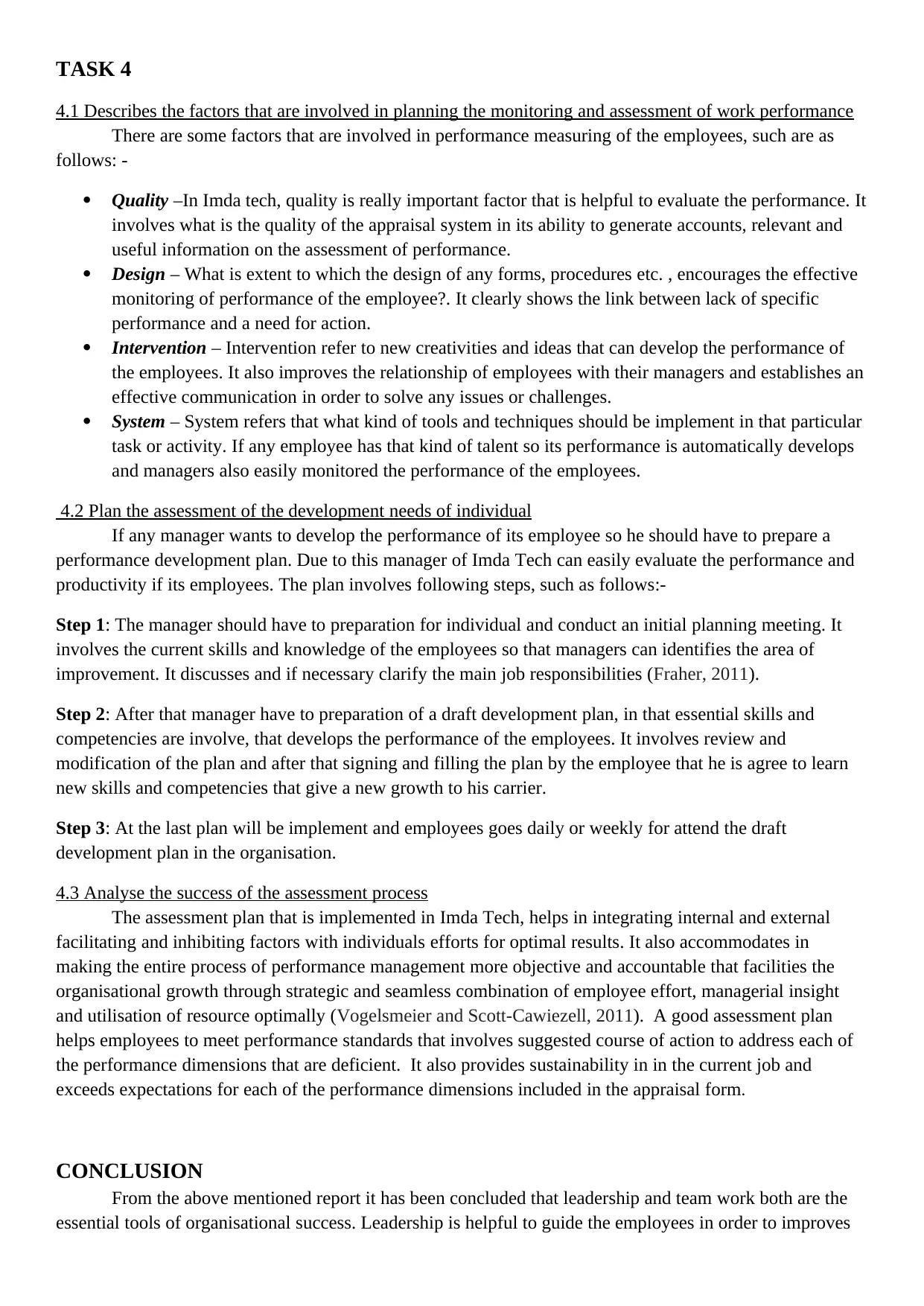
TASK 4
4.1 Describes the factors that are involved in planning the monitoring and assessment of work performance
There are some factors that are involved in performance measuring of the employees, such are as
follows: -
Quality –In Imda tech, quality is really important factor that is helpful to evaluate the performance. It
involves what is the quality of the appraisal system in its ability to generate accounts, relevant and
useful information on the assessment of performance.
Design – What is extent to which the design of any forms, procedures etc. , encourages the effective
monitoring of performance of the employee?. It clearly shows the link between lack of specific
performance and a need for action.
Intervention – Intervention refer to new creativities and ideas that can develop the performance of
the employees. It also improves the relationship of employees with their managers and establishes an
effective communication in order to solve any issues or challenges.
System – System refers that what kind of tools and techniques should be implement in that particular
task or activity. If any employee has that kind of talent so its performance is automatically develops
and managers also easily monitored the performance of the employees.
4.2 Plan the assessment of the development needs of individual
If any manager wants to develop the performance of its employee so he should have to prepare a
performance development plan. Due to this manager of Imda Tech can easily evaluate the performance and
productivity if its employees. The plan involves following steps, such as follows:-
Step 1: The manager should have to preparation for individual and conduct an initial planning meeting. It
involves the current skills and knowledge of the employees so that managers can identifies the area of
improvement. It discusses and if necessary clarify the main job responsibilities (Fraher, 2011).
Step 2: After that manager have to preparation of a draft development plan, in that essential skills and
competencies are involve, that develops the performance of the employees. It involves review and
modification of the plan and after that signing and filling the plan by the employee that he is agree to learn
new skills and competencies that give a new growth to his carrier.
Step 3: At the last plan will be implement and employees goes daily or weekly for attend the draft
development plan in the organisation.
4.3 Analyse the success of the assessment process
The assessment plan that is implemented in Imda Tech, helps in integrating internal and external
facilitating and inhibiting factors with individuals efforts for optimal results. It also accommodates in
making the entire process of performance management more objective and accountable that facilities the
organisational growth through strategic and seamless combination of employee effort, managerial insight
and utilisation of resource optimally (Vogelsmeier and Scott-Cawiezell, 2011). A good assessment plan
helps employees to meet performance standards that involves suggested course of action to address each of
the performance dimensions that are deficient. It also provides sustainability in in the current job and
exceeds expectations for each of the performance dimensions included in the appraisal form.
CONCLUSION
From the above mentioned report it has been concluded that leadership and team work both are the
essential tools of organisational success. Leadership is helpful to guide the employees in order to improves
4.1 Describes the factors that are involved in planning the monitoring and assessment of work performance
There are some factors that are involved in performance measuring of the employees, such are as
follows: -
Quality –In Imda tech, quality is really important factor that is helpful to evaluate the performance. It
involves what is the quality of the appraisal system in its ability to generate accounts, relevant and
useful information on the assessment of performance.
Design – What is extent to which the design of any forms, procedures etc. , encourages the effective
monitoring of performance of the employee?. It clearly shows the link between lack of specific
performance and a need for action.
Intervention – Intervention refer to new creativities and ideas that can develop the performance of
the employees. It also improves the relationship of employees with their managers and establishes an
effective communication in order to solve any issues or challenges.
System – System refers that what kind of tools and techniques should be implement in that particular
task or activity. If any employee has that kind of talent so its performance is automatically develops
and managers also easily monitored the performance of the employees.
4.2 Plan the assessment of the development needs of individual
If any manager wants to develop the performance of its employee so he should have to prepare a
performance development plan. Due to this manager of Imda Tech can easily evaluate the performance and
productivity if its employees. The plan involves following steps, such as follows:-
Step 1: The manager should have to preparation for individual and conduct an initial planning meeting. It
involves the current skills and knowledge of the employees so that managers can identifies the area of
improvement. It discusses and if necessary clarify the main job responsibilities (Fraher, 2011).
Step 2: After that manager have to preparation of a draft development plan, in that essential skills and
competencies are involve, that develops the performance of the employees. It involves review and
modification of the plan and after that signing and filling the plan by the employee that he is agree to learn
new skills and competencies that give a new growth to his carrier.
Step 3: At the last plan will be implement and employees goes daily or weekly for attend the draft
development plan in the organisation.
4.3 Analyse the success of the assessment process
The assessment plan that is implemented in Imda Tech, helps in integrating internal and external
facilitating and inhibiting factors with individuals efforts for optimal results. It also accommodates in
making the entire process of performance management more objective and accountable that facilities the
organisational growth through strategic and seamless combination of employee effort, managerial insight
and utilisation of resource optimally (Vogelsmeier and Scott-Cawiezell, 2011). A good assessment plan
helps employees to meet performance standards that involves suggested course of action to address each of
the performance dimensions that are deficient. It also provides sustainability in in the current job and
exceeds expectations for each of the performance dimensions included in the appraisal form.
CONCLUSION
From the above mentioned report it has been concluded that leadership and team work both are the
essential tools of organisational success. Leadership is helpful to guide the employees in order to improves
Paraphrase This Document
Need a fresh take? Get an instant paraphrase of this document with our AI Paraphraser
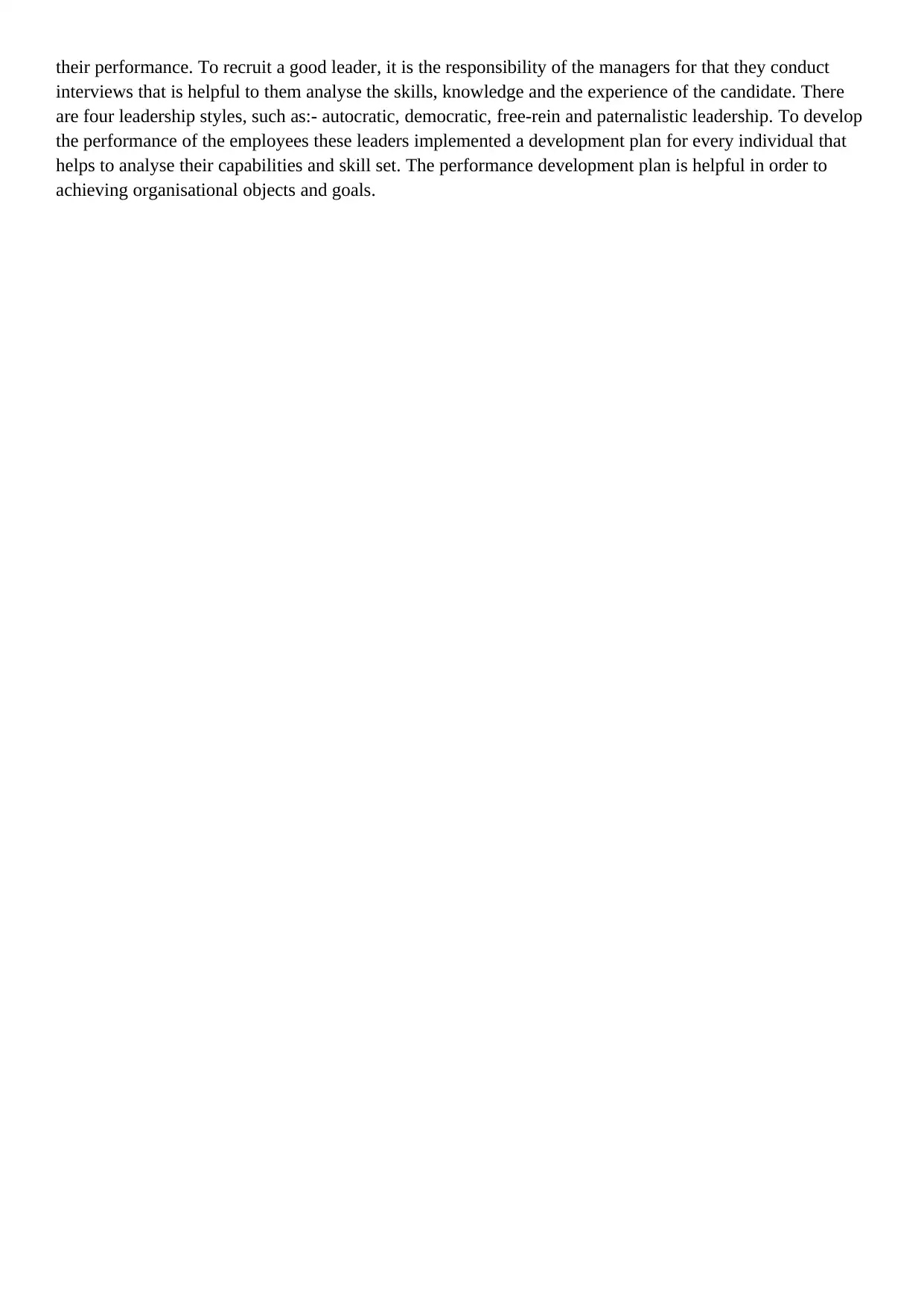
their performance. To recruit a good leader, it is the responsibility of the managers for that they conduct
interviews that is helpful to them analyse the skills, knowledge and the experience of the candidate. There
are four leadership styles, such as:- autocratic, democratic, free-rein and paternalistic leadership. To develop
the performance of the employees these leaders implemented a development plan for every individual that
helps to analyse their capabilities and skill set. The performance development plan is helpful in order to
achieving organisational objects and goals.
interviews that is helpful to them analyse the skills, knowledge and the experience of the candidate. There
are four leadership styles, such as:- autocratic, democratic, free-rein and paternalistic leadership. To develop
the performance of the employees these leaders implemented a development plan for every individual that
helps to analyse their capabilities and skill set. The performance development plan is helpful in order to
achieving organisational objects and goals.
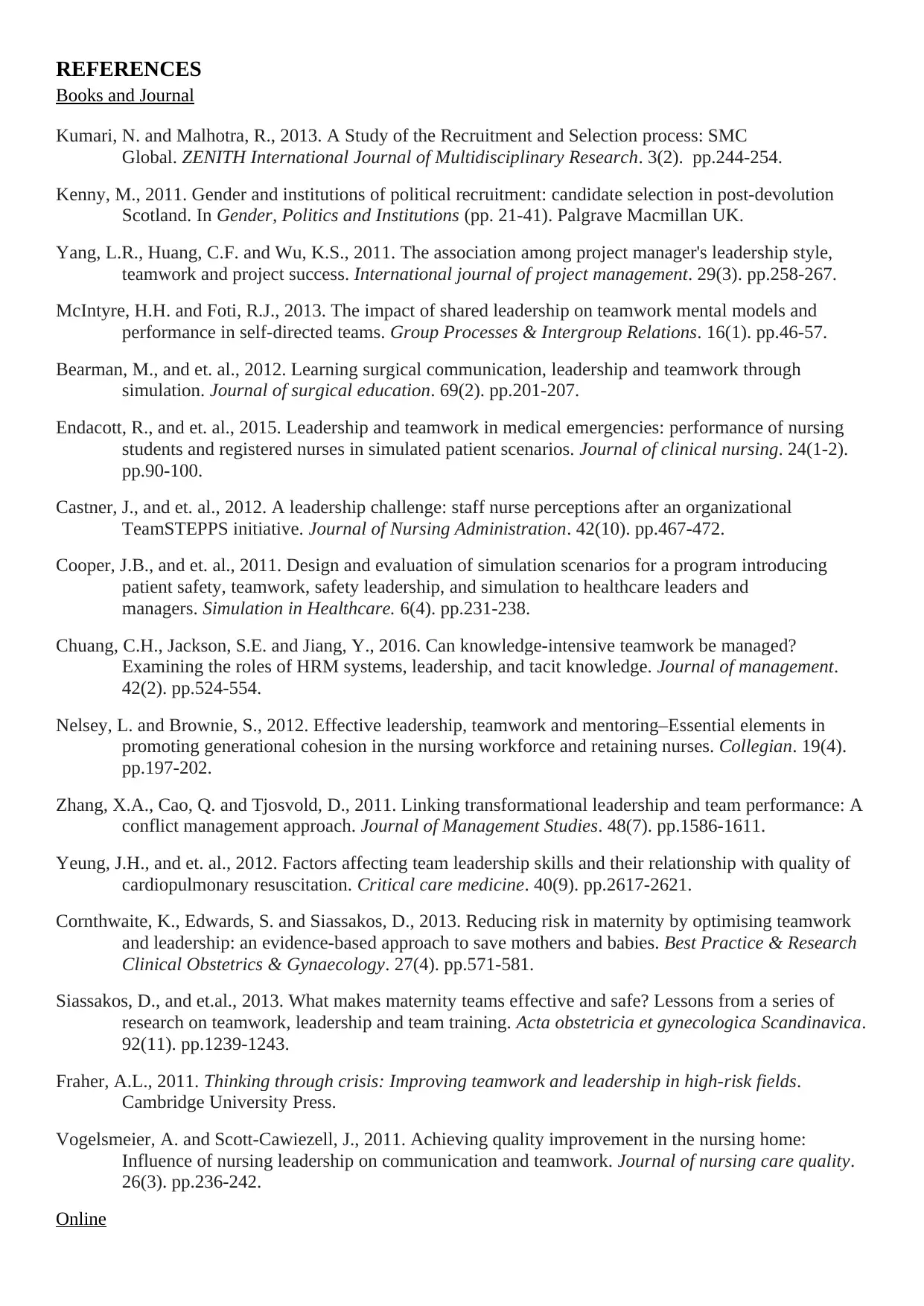
REFERENCES
Books and Journal
Kumari, N. and Malhotra, R., 2013. A Study of the Recruitment and Selection process: SMC
Global. ZENITH International Journal of Multidisciplinary Research. 3(2). pp.244-254.
Kenny, M., 2011. Gender and institutions of political recruitment: candidate selection in post-devolution
Scotland. In Gender, Politics and Institutions (pp. 21-41). Palgrave Macmillan UK.
Yang, L.R., Huang, C.F. and Wu, K.S., 2011. The association among project manager's leadership style,
teamwork and project success. International journal of project management. 29(3). pp.258-267.
McIntyre, H.H. and Foti, R.J., 2013. The impact of shared leadership on teamwork mental models and
performance in self-directed teams. Group Processes & Intergroup Relations. 16(1). pp.46-57.
Bearman, M., and et. al., 2012. Learning surgical communication, leadership and teamwork through
simulation. Journal of surgical education. 69(2). pp.201-207.
Endacott, R., and et. al., 2015. Leadership and teamwork in medical emergencies: performance of nursing
students and registered nurses in simulated patient scenarios. Journal of clinical nursing. 24(1-2).
pp.90-100.
Castner, J., and et. al., 2012. A leadership challenge: staff nurse perceptions after an organizational
TeamSTEPPS initiative. Journal of Nursing Administration. 42(10). pp.467-472.
Cooper, J.B., and et. al., 2011. Design and evaluation of simulation scenarios for a program introducing
patient safety, teamwork, safety leadership, and simulation to healthcare leaders and
managers. Simulation in Healthcare. 6(4). pp.231-238.
Chuang, C.H., Jackson, S.E. and Jiang, Y., 2016. Can knowledge-intensive teamwork be managed?
Examining the roles of HRM systems, leadership, and tacit knowledge. Journal of management.
42(2). pp.524-554.
Nelsey, L. and Brownie, S., 2012. Effective leadership, teamwork and mentoring–Essential elements in
promoting generational cohesion in the nursing workforce and retaining nurses. Collegian. 19(4).
pp.197-202.
Zhang, X.A., Cao, Q. and Tjosvold, D., 2011. Linking transformational leadership and team performance: A
conflict management approach. Journal of Management Studies. 48(7). pp.1586-1611.
Yeung, J.H., and et. al., 2012. Factors affecting team leadership skills and their relationship with quality of
cardiopulmonary resuscitation. Critical care medicine. 40(9). pp.2617-2621.
Cornthwaite, K., Edwards, S. and Siassakos, D., 2013. Reducing risk in maternity by optimising teamwork
and leadership: an evidence-based approach to save mothers and babies. Best Practice & Research
Clinical Obstetrics & Gynaecology. 27(4). pp.571-581.
Siassakos, D., and et.al., 2013. What makes maternity teams effective and safe? Lessons from a series of
research on teamwork, leadership and team training. Acta obstetricia et gynecologica Scandinavica.
92(11). pp.1239-1243.
Fraher, A.L., 2011. Thinking through crisis: Improving teamwork and leadership in high-risk fields.
Cambridge University Press.
Vogelsmeier, A. and Scott-Cawiezell, J., 2011. Achieving quality improvement in the nursing home:
Influence of nursing leadership on communication and teamwork. Journal of nursing care quality.
26(3). pp.236-242.
Online
Books and Journal
Kumari, N. and Malhotra, R., 2013. A Study of the Recruitment and Selection process: SMC
Global. ZENITH International Journal of Multidisciplinary Research. 3(2). pp.244-254.
Kenny, M., 2011. Gender and institutions of political recruitment: candidate selection in post-devolution
Scotland. In Gender, Politics and Institutions (pp. 21-41). Palgrave Macmillan UK.
Yang, L.R., Huang, C.F. and Wu, K.S., 2011. The association among project manager's leadership style,
teamwork and project success. International journal of project management. 29(3). pp.258-267.
McIntyre, H.H. and Foti, R.J., 2013. The impact of shared leadership on teamwork mental models and
performance in self-directed teams. Group Processes & Intergroup Relations. 16(1). pp.46-57.
Bearman, M., and et. al., 2012. Learning surgical communication, leadership and teamwork through
simulation. Journal of surgical education. 69(2). pp.201-207.
Endacott, R., and et. al., 2015. Leadership and teamwork in medical emergencies: performance of nursing
students and registered nurses in simulated patient scenarios. Journal of clinical nursing. 24(1-2).
pp.90-100.
Castner, J., and et. al., 2012. A leadership challenge: staff nurse perceptions after an organizational
TeamSTEPPS initiative. Journal of Nursing Administration. 42(10). pp.467-472.
Cooper, J.B., and et. al., 2011. Design and evaluation of simulation scenarios for a program introducing
patient safety, teamwork, safety leadership, and simulation to healthcare leaders and
managers. Simulation in Healthcare. 6(4). pp.231-238.
Chuang, C.H., Jackson, S.E. and Jiang, Y., 2016. Can knowledge-intensive teamwork be managed?
Examining the roles of HRM systems, leadership, and tacit knowledge. Journal of management.
42(2). pp.524-554.
Nelsey, L. and Brownie, S., 2012. Effective leadership, teamwork and mentoring–Essential elements in
promoting generational cohesion in the nursing workforce and retaining nurses. Collegian. 19(4).
pp.197-202.
Zhang, X.A., Cao, Q. and Tjosvold, D., 2011. Linking transformational leadership and team performance: A
conflict management approach. Journal of Management Studies. 48(7). pp.1586-1611.
Yeung, J.H., and et. al., 2012. Factors affecting team leadership skills and their relationship with quality of
cardiopulmonary resuscitation. Critical care medicine. 40(9). pp.2617-2621.
Cornthwaite, K., Edwards, S. and Siassakos, D., 2013. Reducing risk in maternity by optimising teamwork
and leadership: an evidence-based approach to save mothers and babies. Best Practice & Research
Clinical Obstetrics & Gynaecology. 27(4). pp.571-581.
Siassakos, D., and et.al., 2013. What makes maternity teams effective and safe? Lessons from a series of
research on teamwork, leadership and team training. Acta obstetricia et gynecologica Scandinavica.
92(11). pp.1239-1243.
Fraher, A.L., 2011. Thinking through crisis: Improving teamwork and leadership in high-risk fields.
Cambridge University Press.
Vogelsmeier, A. and Scott-Cawiezell, J., 2011. Achieving quality improvement in the nursing home:
Influence of nursing leadership on communication and teamwork. Journal of nursing care quality.
26(3). pp.236-242.
Online
⊘ This is a preview!⊘
Do you want full access?
Subscribe today to unlock all pages.

Trusted by 1+ million students worldwide

Teamwork and Leadership. 2017. [Online]. Available through: < https://saylordotorg.github.io/text_business-
communication-for-success/s23-05-teamwork-and-leadership.html>. ]Accessed on 6th May 2017].
Why is Teamwork Important?. 2017. [Online]. Available through: <
http://the-happy-manager.com/articles/why-is-teamwork-important/>. [Accessed on 6th May 2017].
communication-for-success/s23-05-teamwork-and-leadership.html>. ]Accessed on 6th May 2017].
Why is Teamwork Important?. 2017. [Online]. Available through: <
http://the-happy-manager.com/articles/why-is-teamwork-important/>. [Accessed on 6th May 2017].
1 out of 10
Related Documents
Your All-in-One AI-Powered Toolkit for Academic Success.
+13062052269
info@desklib.com
Available 24*7 on WhatsApp / Email
![[object Object]](/_next/static/media/star-bottom.7253800d.svg)
Unlock your academic potential
Copyright © 2020–2025 A2Z Services. All Rights Reserved. Developed and managed by ZUCOL.





